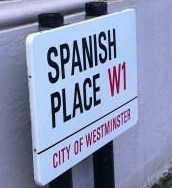![La Belle Otero, by Reutlinger [Wikimedia Commons]](https://hispanicbritain.files.wordpress.com/2014/09/la_belle_otero_reutlinger.jpg?w=182&h=300) Sometimes the snippets I come across in the British Newspaper Archive are just too much fun not to be shared. For the last few days, as part of the research for Chapter 5 of The Edwardians and the Making of a Modern Spanish Obsession, I’ve been tracing Spanish dancers around London and (more interestingly) provincial music halls. On the way, I’ve discovered just how deeply the figure of the ‘Spanish dancer’ was embedded into the Edwardian public imagination.
Sometimes the snippets I come across in the British Newspaper Archive are just too much fun not to be shared. For the last few days, as part of the research for Chapter 5 of The Edwardians and the Making of a Modern Spanish Obsession, I’ve been tracing Spanish dancers around London and (more interestingly) provincial music halls. On the way, I’ve discovered just how deeply the figure of the ‘Spanish dancer’ was embedded into the Edwardian public imagination.
There were the legendary dancers themselves, of course, like La Belle Otero (left) and her rivals Guerrero and Tortajada, who never seemed to be off the London stage in the first years of the 20th century. But there were also ‘Spanish dancers’ peopling art galleries, novels, concert rooms, end-of-the-pier shows and – of course! – fancy dress balls. Between 1898 and 1914, every – and I mean EVERY – fancy dress ball, from Lands End to John o’Groats featured at least one young lady or stout matron attired as a Spanish dancer, although history does not, unfortunately, relate how many of them were willing to dance the dance as well as wear the skirts.
The Spanish Dancer was truly ubiquitous at the turn of the 20th century. As The Era asked rhetorically in 1900, ‘which music hall now has not a Spanish dancer?’ (1 Sep. 1900: 18). Of course, this ubiquity could lead to overkill, when Spanish dancers were shoehorned into such unlikely places as the topical drama Boers and Britons (Leighton Buzzard Corn Exchange, March 1900), where said dancer briefly takes the stage mid-play, presumably with the intention of providing a little light relief. But at other times, she could be used as a mouthpiece for real reflections on the relationship between British and Spanish culture, which I think is the case in the example I’ve found here in the Whitstable Times of 18 August 1906.
Weazels for Dancers: A Fair Swap?
If I understand correctly, at the beginning of the 20th century, the Canterbury Old Stagers theatre company (founded 1842 and still performing!) had a tradition of providing what they called ‘epilogues to their local variety shows. In the summer of 1906, one such epilogue – Grievances Limited, by Lieutenant-Colonel Newnham Davis – provided a spirited response to the Anglo-Spanish royal wedding that had taken place in Madrid a couple of months earlier. Helpfully, the Whitstable Times reprinted the whole text, which allows us to see an example of the kind of ephemeral, local performances that are now generally lost.
The scene takes place about halfway through the epilogue. As the orchestra strikes up Bizet’s Carmen, a Spanish Dancer enters ‘defiantly … smoking a cigarette. She swaggers round, stamps, and addresses the Manager’ with a brusque ‘y Habla Espanol? Caramba! Olé’, before continuing in song:
This is what I say:
Since your Princess was to Alphonso wed,
No Spanish songs are sung in Spain, instead
Our audiences your English ballads crave,
“Pop goes the Weazel,” “Britain rules the wave.”
No more guitars are thrummed, and we, the dancers,
Have got to learn the polka and the lancers.
An English character, Phyllis, then responds in kind:
A grievance, truly, one that’s hard to bear,
But if they’re very English over there,
We’re all Castilian here. I will not speak
About that Spanish terror the Maxixe
We’re all devoted to your slim Guerrero,
To Tortahaga [sic] and to dark Otero.
Won’t you oblige?
After a little persuasion the Spanish Dancer agrees, and the audience are treated to a Spanish dance (although presumably not the Maxixe, which is in fact Brazilian). This little sketch is a fascinating glimpse into how one local theatre company interpreted the new ties between Britain and Spain in 1906, and their possible consequences – at least for the world of showbusiness. I’ve not been able to find any other records of the production, so if you know something, please do get in touch!
